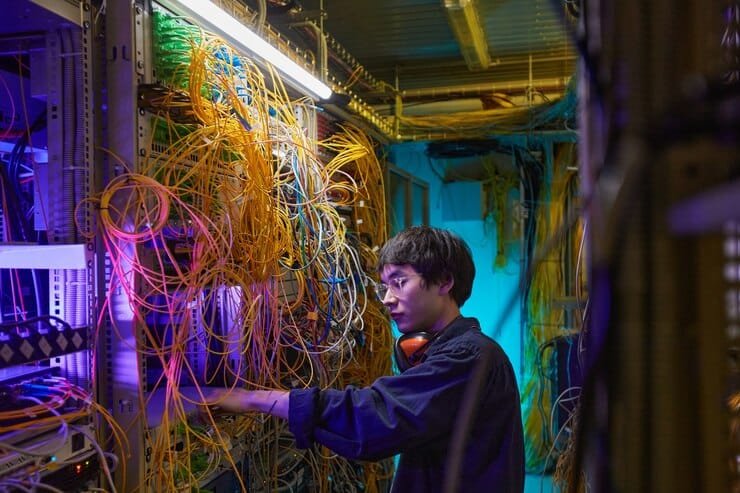Overview: Fiber Optics: Revolutionizing Telecom & Electronics – or Obliterating Them?
The Shifting Sands of Connectivity
The landscape of telecommunications and electronics is undergoing a profound transformation, driven largely by the relentless advancement of fiber optic technology. Currently, global networks rely heavily on fiber optic cables for high-speed data transmission, forming the backbone of the internet, telecommunication networks, and even critical infrastructure systems. This prevalence is no accident; fiber’s capacity for transmitting massive amounts of data with minimal signal loss has rendered older copper-based systems increasingly obsolete. The market reflects this shift: industry analysis predicts continued exponential growth in the fiber optic sector, particularly in areas like 5G deployment, data center interconnects, and Fiber-to-the-Home (FTTH) initiatives [1].
Why Fiber Matters: The Stakes are High
The implications of fiber optic technology extend far beyond faster internet speeds. For business leaders and telecommunications professionals, understanding the nuances of this technology is critical for strategic planning. The ongoing evolution of fiber optics dictates the speed, efficiency, and capacity of their networks. As demand for data-intensive applications like cloud computing, artificial intelligence, and the Internet of Things (IoT) continues to surge, dependence on fiber optics will only intensify. Failure to adapt could lead to stagnation and render legacy infrastructures not merely less efficient but effectively redundant. However, simply embracing fiber without carefully considering the rapidly evolving technological and competitive landscape, risks considerable expense [2]. This blog post will explore the current state of fiber optics within telecom and electronics, including a discussion of future challenges and trends.
Key Areas of Exploration
This blog post will delve into the following core areas:
- Current Market Dynamics: An overview of the present state of the fiber optic equipment market, key players, and regional trends.
- Technological Advancements: Exploring recent innovations in fiber optic materials, transmission techniques, and network architectures.
- Strategic Implications: Evaluating the impact of fiber optics on network deployment, costs, and return on investment.
- Future Outlook: A look at emerging technologies that will shape the future of fiber optic communications, and the challenges they pose to existing infrastructure.
- Competitive Analysis: Examining the current ecosystem, market dynamics, and the impacts on the sector.
By providing an objective, fact-based analysis, this post intends to equip fiber-optic equipment professionals, and business leaders responsible for Telecommunications Equipment, with the knowledge necessary to make informed decisions in this rapidly evolving sector.
Fiber-Optic Equipment Market: Key Trends and Strategic Implications
The fiber-optic equipment market is experiencing dynamic shifts, driven by evolving technological needs and global infrastructure developments. These trends necessitate strategic adaptation for businesses operating within the sector.

Positive Trends
- Exponential Growth in Data Demand: The insatiable appetite for data, fueled by cloud computing, streaming services, IoT devices, and 5G deployment, is driving the need for higher bandwidth and faster data transmission speeds. This directly translates into increased demand for advanced fiber-optic equipment. Example: Companies like Cisco are seeing increased orders for their high-capacity optical networking equipment to meet the needs of data centers and telecom providers.
- Driving Factor: The proliferation of data-intensive applications and the increasing reliance on digital infrastructure.
- Impact: Increased market size and revenue opportunities for manufacturers of optical transceivers, amplifiers, cables, and related infrastructure components.
- Analyst Recommendation: Prioritize investment in R&D to develop next-generation, higher-speed and lower-latency equipment. Focus on solutions optimized for emerging use cases, like edge computing and hyperscale data centers.
- 5G Rollout & Network Modernization: The ongoing deployment of 5G networks requires dense fiber infrastructure for backhaul and fronthaul. This creates significant demand for fiber-optic cables, connectors, and related equipment. Example: Nokia’s optical networking division is benefiting from increased operator spending on 5G infrastructure.
- Driving Factor: Need for high-speed, low-latency connectivity to support 5G use cases and increasing adoption of small cell infrastructure.
- Impact: Strong demand for advanced optical transport solutions, including coherent transceivers, and a shift towards densified fiber networks.
- Analyst Recommendation: Expand production capacity to meet the accelerated deployment of 5G, and tailor solutions for the specific requirements of diverse network topologies, for example, urban vs rural deployment scenarios.
- Adoption of Passive Optical Networks (PON): PON technologies, particularly XGS-PON, are gaining traction as a cost-effective and scalable solution for delivering high-speed broadband to homes and businesses. Example: Companies like ADTRAN are heavily promoting their PON solutions to telecom operators.
- Driving Factor: The increasing push for fiber-to-the-home (FTTH) deployments and the demand for cost-effective high-speed internet access, particularly in rural and underserved areas.
- Impact: Significant opportunities for manufacturers of OLT (Optical Line Terminal) and ONT (Optical Network Terminal) equipment, plus the associated passive components.
- Analyst Recommendation: Develop interoperable and cost-optimized PON solutions to cater to the varied demands of different regions and network providers. Explore options for next-gen PON technologies beyond XGS-PON to prepare for future capacity needs.
Adverse Trends
- Supply Chain Disruptions: The global semiconductor shortage, coupled with logistics bottlenecks, has created challenges for fiber-optic equipment manufacturers, impacting production costs and lead times. Example: Many manufacturers experienced delayed deliveries and increased component costs throughout 2022 and 2023, impacting overall project timelines.
- Driving Factor: Geopolitical instability, pandemic-related factory closures, and a surge in demand across multiple industries.
- Impact: Increased production costs, longer delivery times, and potential loss of market share due to inability to fulfill orders promptly.
- Analyst Recommendation: Diversify supply chains, build strategic inventory, and explore alternative materials and manufacturing processes to mitigate risks. Consider long-term agreements with key suppliers.
- Intensified Competition: The fiber-optic equipment market is becoming increasingly competitive, with both established players and emerging vendors vying for market share. This can pressure pricing and profitability. Example: Increased competition from Asian manufacturers is putting pressure on established Western firms.
- Driving Factor: Market growth attracts new entrants, particularly from lower-cost manufacturing regions, along with increased consolidation of bigger companies with more diverse offerings
- Impact: Price erosion, reduced profit margins, and increased pressure on businesses to differentiate themselves through technological innovation and value-added services.
- Analyst Recommendation: Invest in R&D to develop differentiated products, enhance customer service, and build strong brand recognition. Consider strategic partnerships or acquisitions to expand product portfolios or geographical reach.
- Skilled Labor Shortage: The increasing complexity of fiber-optic technology requires a highly skilled workforce, but there is a growing shortage of qualified engineers and technicians, which can slow down innovation and deployment. Example: Many companies struggle to find skilled optical engineers and fiber installers, causing project delays.
- Driving Factor: Rapid technological advancements, and limited training programs for specialized skills.
- Impact: Delays in product development, implementation challenges, and increased labor costs.
- Analyst Recommendation: Invest in internal training programs, collaborate with educational institutions to develop specialized curriculum, and explore automation solutions to optimize labor resources.
Conclusion:
The fiber-optic equipment market presents significant opportunities alongside challenges. By leveraging positive trends such as the growth in data demand, 5G rollouts, and PON adoption, while mitigating adverse trends, such as supply chain disruptions, intense competition, and labor shortages, businesses can position themselves for long-term success. Strategic investment in R&D, supply chain resilience, talent acquisition, and customer-centric solutions will be critical for navigating this rapidly evolving landscape.
Healthcare
- Medical Imaging: Hospitals utilize fiber optic cables extensively in diagnostic equipment like MRI and CT scanners. These cables transmit high-resolution images rapidly, enabling quicker diagnosis and treatment planning. This reduces patient wait times and improves overall efficiency. The high bandwidth allows for complex 3D imaging and real-time visualization.
- Surgical Robotics: Fiber optics are critical in robotic surgery systems. They facilitate the transmission of video signals from tiny cameras, enabling surgeons to have a highly detailed view of the surgical site. Precise control of robotic arms via fiber optic links allows for minimally invasive procedures, resulting in faster recovery times.
- Patient Monitoring: Fiber-based sensors are being used to monitor physiological data, such as heart rate and blood oxygen levels. These sensors are more accurate and less intrusive than traditional methods and transmit data via fiber optic lines to a central monitoring station. This real-time data aids in identifying critical changes in patient conditions swiftly.
Technology
- Data Centers: Fiber optic cabling is the backbone of modern data centers. It provides the necessary high-speed connections between servers, storage systems, and network switches. The low latency and high bandwidth enable fast data transfer, crucial for cloud computing, content delivery networks, and online services.
- Telecommunications Networks: Fiber optic networks are deployed by telecom companies to provide high-speed internet, phone services, and television. Fiber’s superior signal quality and capacity, compared to copper wires, allow for faster download and upload speeds, supporting bandwidth-intensive applications like video streaming and online gaming.
- High-Performance Computing: Research institutions and businesses use fiber optic infrastructure to connect high-performance computing clusters. This allows for fast communication between processors, which enables them to tackle computationally intensive problems such as weather forecasting, drug discovery, and advanced simulations.
Automotive
- In-Vehicle Networking: Modern vehicles use fiber optic cables for high-speed data transfer in in-car entertainment and advanced driver-assistance systems (ADAS). Fiber is used to create a secure, high-bandwidth communication pathway for technologies like cameras, sensors, and navigation systems. This reduces latency and interference, crucial for safety-related functions.
- Autonomous Driving Systems: Autonomous vehicles rely on fiber optics to transmit data from sensors, cameras, and LiDAR systems to central control units. This enables the quick processing of vast amounts of data needed to make critical decisions in real-time. The high bandwidth and low latency are essential for the vehicle’s safe navigation.
Manufacturing
- Industrial Automation: Fiber optic cables are employed in industrial automation systems to connect sensors, controllers, and robotic arms. Fiber’s ability to transmit data at high speed and with low latency is crucial for synchronizing the various components in a manufacturing plant and enabling rapid, precise operation.
- Quality Control Systems: Fiber optics are used to transmit data from high-resolution cameras and sensors used in quality control systems. These systems rapidly inspect products on the production line, identifying defects that can be corrected before they reach the consumer.
Key Strategies in Fiber-Optic Equipment (2023 Onward)
Organic Growth Strategies:
- Product Innovation and Diversification: Companies are aggressively investing in R&D to develop next-generation fiber optic equipment. This includes higher capacity transceivers (400G, 800G, and beyond), advanced optical transport network (OTN) solutions, and more energy-efficient components. For instance, companies like Nokia and Ciena are enhancing their portfolios with products specifically designed for increasing bandwidth demands in data centers and 5G networks, focusing on better performance and reduced power consumption.
- Focus on Software-Defined Networking (SDN) and Automation: There’s a push to integrate SDN and network automation to enable more flexible and efficient fiber network management. Companies like Juniper Networks and Adtran are offering solutions that simplify network operations, reduce human intervention and optimize resource utilization. This includes the use of AI-driven network analytics and predictive maintenance capabilities, allowing for faster service deployment and issue resolution.
- Geographic Expansion: Firms are targeting expansion into emerging markets, where fiber network deployments are rapidly increasing. Companies are establishing local partnerships, building sales channels, and tailoring their product offerings to fit the unique requirements of these markets. For example, Corning, with its established presence in mature markets, continues to grow its market share in rapidly developing regions in South America and Asia.
Inorganic Growth Strategies:
- Strategic Acquisitions: Companies are acquiring smaller firms that offer complementary technologies or specialized products to broaden their offerings and gain a competitive edge. For example, CommScope acquired Cablelink to enhance its portfolio in access network solutions and expand its product portfolio. This strategy allows companies to quickly bring new tech to the market or gain expertise in a specific sector.
- Joint Ventures and Partnerships: To reduce risk and resources, many firms are entering joint ventures to develop new products and expand their distribution networks. Fujikura recently signed collaboration agreements with multiple technology firms to develop next-gen splicing technology for high speed optical fiber connections. These partnerships also offer access to new technologies and help in gaining more market access.
- Investment in Startups and Venture Capital: Companies are investing in promising startups that are working on cutting-edge fiber optic technology. This helps in gaining early access to innovation, secure future product capabilities and identify emerging trends. For instance, II-VI Incorporated (now Coherent), through its venture capital arm, invests in companies with breakthrough technologies related to lasers and photonics used in fiber optics, ensuring continuous technology advancement and a steady supply of new technology.

Outlook & Summary: Fiber Optics in the Next Decade
Outlook: The Evolving Fiber Landscape
The next 5 to 10 years will likely witness a significant expansion and refinement of fiber optic technology and infrastructure. Driven by increasing bandwidth demands from 5G, IoT, and cloud computing, the fiber optics equipment market is projected to experience robust growth. Expect to see:
- Higher Capacity & Speeds: Continued advancements in optical transceiver technology, including coherent optics, will enable faster data transmission rates and increased network capacity. This means continued investment in equipment upgrades.
- Miniaturization & Integration: A trend towards smaller, more energy-efficient components will facilitate wider deployment in diverse environments, potentially reducing costs associated with installation and upkeep.
- Increased Automation: Automated manufacturing and deployment processes will become increasingly prevalent to meet growing demand, as will AI-powered network management tools.
- Diversification of Applications: Beyond traditional telecom applications, fiber optics will likely see greater adoption in data centers, industrial settings, and potentially even emerging fields like quantum computing.
Key Takeaway: A Sector in Transformation
The article highlights that fiber optic equipment is not just a component of the telecommunications sector, it is rapidly becoming the defining infrastructure. While the broader Telecommunications Equipment sector encompasses diverse technologies, the future clearly leans heavily on fiber’s ability to provide the bandwidth and speed required for upcoming technological advancements. The continued demand for fiber equipment indicates a potential shift where its growth disproportionately outpaces other, legacy elements of the Telecom sector. This implies companies focused on fiber optic solutions may hold a position of increasing strength, while others may need to adapt to remain competitive.
The Future is Now
The long term outlook is that the future of telecommunications, data infrastructure, and beyond is undeniably intertwined with the progression of fiber optic technology. This transition requires the careful consideration of both technical advancement and business strategy.
Considering the profound shift towards fiber optics, what proactive steps is your organization taking to integrate and leverage this rapidly evolving technology to secure its future competitiveness?


